April 2021, Vol. 248, No. 4
Features
Improving Natural Gas Distribution Systems to Ease Pressure Risks
By C. David Slavin, P.E, Burns McDonnell
Natural gas is an essential commodity used for generating electricity, fueling vehicles, cooking and more. In the United States alone, it is supplied through networks of pipelines spread across millions of miles.
Protecting these pipelines and the public from both internal and external damage is crucial because natural gas can be hazardous, and a break in the distribution network can threaten public safety and cause serious economic losses. One such challenge faced by utilities is overpressure events in their pipelines and how to properly protect against them.
This article examines redundant overpressure protection (OPP) requirements at the city gates in the U.S. and how several operators are at risk of noncompliance as states begin to enforce redundant OPP requirements specifically at the city gates.
Different OPP solutions are available in the market. It is up to each utility to evaluate its existing system and identify suitable safety devices that comply with federal regulations and safeguard the pipeline distribution network from accidents.
Setting Standards
For organizations involved with natural gas transmission and distribution pipeline systems, American Society of Mechanical Engineers (ASME) B31.8 is an essential reference. It is the most widely used code for the design, operation, maintenance and repair of those pipelines. ASME B31.8 recommends wide-ranging solutions for design, construction, materials, testing, assessment and more.
As shown in Figure 1, OPP devices are placed at the gate station between the transmission company and the utility (or power plant lateral). Facilities and piping indicated by solid lines are within the scope of ASME B31.8. Historically, it has been the practice of transmission companies to supply the OPP device when reducing the pressure at the city gate. Otherwise, the utility would typically design its system for the same or greater maximum allowable operating pressure (MAOP), and no OPP device would be installed. (Figure 1)
There are two types of typical city gate arrangements, flow control and pressure control, depending on the requirements of the downstream user (in this case, the utility). Flow control (Figure 2) interconnects typically include metering, a flow control valve (FCV) and some type of custody break point.
Depending on the contractual requirements, there might also be some type of filtration device. A pressure control arrangement (Figure 3) will typically also include a worker/monitor control valve arrangement that reduces the pressure at the interconnect. (Figure 2 & 3)
OPP Requirements
You might design your system to the same MAOP as the transmission line feeding your system, or the transmission company provides some type of pressure reduction and OPP arrangement.
Even then, the Pipeline and Hazardous Materials Safety Administration (PHMSA) says this still does not meet the intent of the code, since the utility is unable to produce a record to meet the requirements of Code of Federal Regulations (CFR) 192.195 (See blue box, “UNDERSTANDING 49 CFR 192.195.”) PHMSA maintains that even with all the safety precautions and experience, it is still possible for the transmission company to have an overpressure event, causing a failure on the utility’s system, and it is the ultimate responsibility of the utility to protect its assets and customers.
This has already been a requirement at the federal level for several years, but an increasing number of states are enforcing this requirement at the utility commission level.
Understanding 49 CFR 192.195
Utilities unaware of regulations may inadvertently be noncompliant. Keeping up with regulatory revisions can help utilities plan for upcoming changes. Given all the requirements accompanying the recent release of a mega rule, utilities need time to plan for upgrades and retrofits. The rule in 49 CFR 192.195 provides the following guidelines:
If the pipelines connected to a gas source exceed the MAOP, which could result in pressure control failure or some other type of failure, they must have pressure-relieving or pressure-limiting devices that meet the requirements of 192.199 and 192.201.
Each distribution system supplied from a source of gas that is at a higher pressure than the MAOP for the system must:
- Have pressure regulation devices capable of meeting the pressure, load and other service conditions experienced in normal operation of the system, and which could be activated in the event of failure of some portion of the system.
- Be designed to prevent accidental over-pressuring.
- Regulating bodies (PHMSA and utility commissions) inspect facilities and check records for pipeline OPP regularly, to see that all the regulatory requirements are met. Any organization found to be out of compliance faces consequences, which could involve fines up to $2 million, legal action or both.
A utility must not rely solely on the upstream supplier providing OPP for maintaining inspection records, whether there are any changes in pressure or not. It should maintain its own records, so they are available whenever required.
Also, most transmission companies will not provide these records to their customer. It is typically spelled out in the interconnection agreement, which is the responsibility of the customer to provide its own OPP according to CFR 192.195.
As instructed by the U.S. Department of Transportation (DoT), under pipeline safety regulations, operators are responsible for protecting their pipelines from pressure control failures.
They must therefore either maintain their own OPP devices or monitor the supplier’s device and record the type, location and inspection date for each device. These records should be traceable, verifiable, complete and reliable.
But it does beg the question: How could your system overpressurize?
Event Case Study
In 2005, Southern Star Central Gas Pipeline’s (SSCGP) Ottawa station was struck by lightning, resulting in the programmable logic controller (PLC) shutting down the station and an increase in the MAOP for the Topeka (ES 20-inch) pipeline.
After the power was restored, the PLC placed the station in local control and automatically moved valves and set points to the last known positions. Later, a potential pipeline rupture was reported south of Lawrence, Kansas. However, the control center had not received any alarm about a loss in pressure.
As designed, when power was lost at the Ottawa station, the working regulator on the ES 20-inch line failed in the open position. The monitor regulator failed to operate; this regulator was designed to protect the ES 20inch pipeline from overpressure in the event of any type of malfunction of the working regulator.
With the working monitor in the open position and the monitor regulator not operational, the ES 20-inch pipeline was exposed to a pressure above the MAOP. The established MAOP was 450 psig (31 bar), and the maximum pressure experienced at the Ottawa station was 680 psig (47 bar).
It was later determined that the monitor regulator failed to operate because the pneumatic controller supply valve was in a closed position. The supply valve apparently was left closed by a technician who had been performing maintenance activities on the monitor regulator. Because of this incident, 12 domestic customers were without gas service for two days.
This is one example of an overpressure event that could damage the utility’s system. In this instance, one type of pressure reduction facility failed due to operator error. If the city gate were interconnected on this section of the transmission main, the system could also overpressurize, confirming PHMSA concerns.
OPP Solutions
Different types of OPP can be installed at the city gate, which is owned and operated by the utility. These include:
Monitor control valve: This system typically consists of a worker and monitor control valve. When one control valve fails, the other continues to maintain the downstream pressure. One solution at the gate station is to install a monitor control valve and use the transmission company FCV as the worker. This way if the FCV ever failed, the monitor pressure control valve would take over and protect the downstream system from an overpressure event.
Relief valve: Also known as a pressure relief valve (PRV), this is a safety valve installed to control the pressure of gas in the pipeline. It is designed to open at a preset pressure and close when pressure returns to a safe level. It protects pipelines and equipment from damage that can be caused by overpressure.
These valves are installed downstream of the transmission company’s FCV. Although relief valves have been used for decades and have helped in controlling pressure, they make a lot of noise and vent flammable and potentially harmful greenhouse gas emissions into the atmosphere while relieving pressure.
Shutoff valve: This provides an additional layer of protection in case the first layer does not perform the job. Shutoff valves can be individual devices or part of an overall OPP system. Their purpose is to stop the flow of gas upon sensing that the pressure has exceeded the preset limit.
This protects and shuts down the system until the cause of failure is detected and rectified. The biggest concern with shutoff valves is they could falsely trip and shut out the downstream utility system, which could have larger operational and maintenance implications if not fixed immediately.
Another potential solution is to have the interconnection agreements state that if there is OPP equipment on the transmission company’s side, there must be a way to verify that it meets the requirements of CFR 192.195.
It should give permission to the utility to witness the inspection of the transmission company’s OPP system annual testing, allowing the operator to produce its own record. This has been an effective solution for some utilities when the city gate has some type of pressure control facilities to meet the intent of this section of the code.
Conclusion
Safely transporting natural gas is a priority for gas utilities. Natural gas transmission and distribution systems are intricate and evolving. Analyzing the existing system and understanding its limitations will assist in deploying the most suitable OPP and safety systems to meet regulatory requirements and provide safe, reliable service.
Author: C. David Slavin is a senior project engineer at Burns & McDonnell. He has more than 10 years of experience in planning, designing and managing engineering projects for pipelines and pipeline facilities, including installing M&R stations across the country. He has specialized knowledge in metering and OPP requirements and has spoken at trade associations across the country, including the American Gas Association and the Southern Gas Association. Slavin earned his Bachelor of Science degree in engineering from the Colorado School of Mines.








Comments